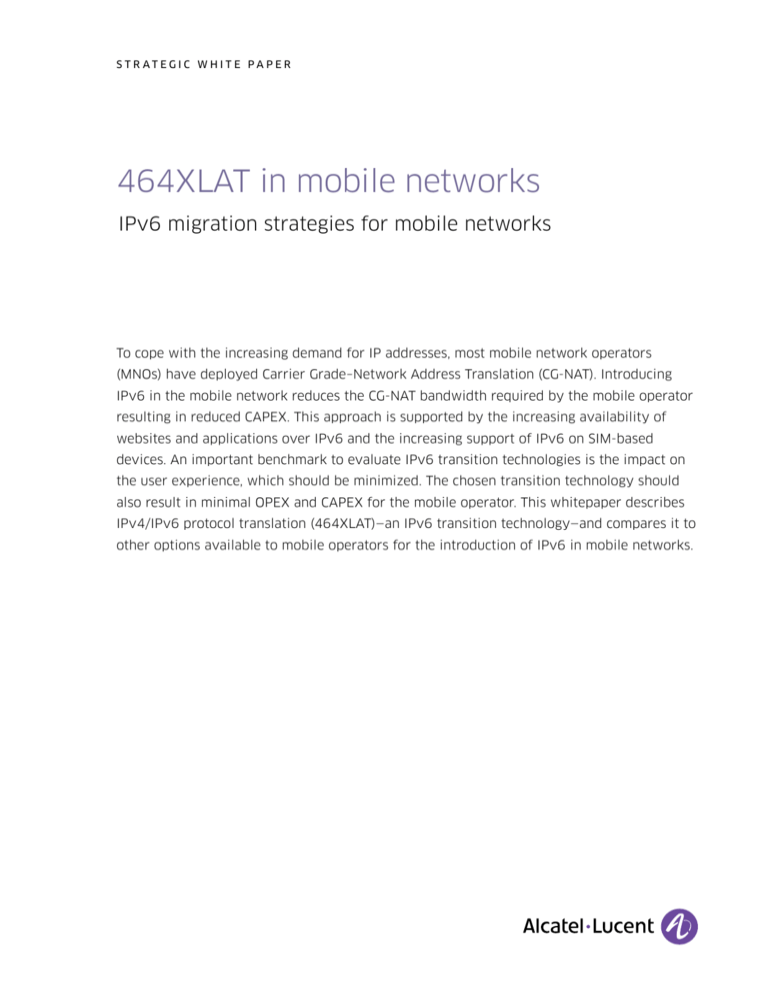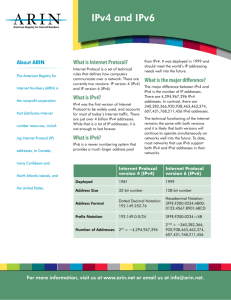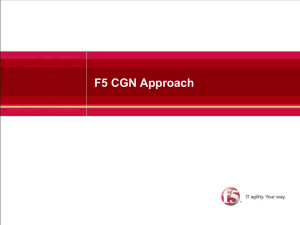
S T R AT EG IC W HI T E PA P E R
464XLAT in mobile networks
IPv6 migration strategies for mobile networks
To cope with the increasing demand for IP addresses, most mobile network operators
(MNOs) have deployed Carrier Grade–Network Address Translation (CG-NAT). Introducing
IPv6 in the mobile network reduces the CG-NAT bandwidth required by the mobile operator
resulting in reduced CAPEX. This approach is supported by the increasing availability of
websites and applications over IPv6 and the increasing support of IPv6 on SIM-based
devices. An important benchmark to evaluate IPv6 transition technologies is the impact on
the user experience, which should be minimized. The chosen transition technology should
also result in minimal OPEX and CAPEX for the mobile operator. This whitepaper describes
IPv4/IPv6 protocol translation (464XLAT)—an IPv6 transition technology—and compares it to
other options available to mobile operators for the introduction of IPv6 in mobile networks.
Table of contents
Introduction
1
/
IPv6 to 3GPP standards and mobile networks
IPv6 migration strategies
/
1
Do nothing – IPv4 only / 1
The traditional way – IPv4 and IPv6 / 2
Drastic – IPv6 only / 2
Improved – IPv6 only + NAT64 / 2
The smart way – IPv6 only + 464XLAT / 2
464XLAT in mobile networks
Native IPv6 / 3
DNS64 / 4
CLAT / 4
PLAT / 4
Conclusion
Acronyms
References
4
/
5
/
/
5
/
3
/
1
Introduction
IPv6 addressing is vital in today’s mobile networks. IPv4 addresses are depleted so there is an
insufficient number of addresses for the rapidly escalating number of mobile devices. Support for
IPv6 on mobile network equipment, as well as on handheld user equipment (UE) is becoming more
prevalent. MNOs now have multiple options to transition to IPv6 in their networks at a low cost.
However, IPv4-only websites and applications still remain on the Internet, which require CG-NAT.
The MNO’s goal should be to minimize the traffic that has to pass CG-NAT. Or, to put it differently, the
IPv6-to-IPv4 traffic ratio should be optimized as much as possible. To do this, the MNO must introduce
IPv6 access to customer devices. As a result, network migration to IPv6 becomes a strategic decision
that must be carefully considered.
IPv6 to 3GPP standards and mobile networks
The 3rd Generation Partnership Project (3GPP) maintains the standards for General Packet Radio
Service (GPRS)-based 2G/3G wireless access networks and System Architecture Evolution (SAE) for LTE
and LTE-Advanced wireless access. IPv6 was introduced into these standards with Release 99. However,
it was not widely implemented by equipment vendors, nor was it extensively deployed by MNOs.
Most 3G network deployments today are based on Release 7, using the generic tunneling protocol
(GTPv1). A separate bearer is required for IPv4 and IPv6 access. This has a scaling impact on the
mobile core by significantly increasing the number of bearers on the GPRS Gateway Serving Node
(GGSN). 464XLAT overcomes this issue, while also enabling the introduction of IPv6 for 3G networks
without the need for a major network upgra mde.
For its part, Release 8 introduced Evolved-UMTS Terrestrial Radio Access (E-UTRA). E-UTRA is
designed to provide a single evolution path for a wide range of radio access technologies. Release 8
defines the new Evolved Packet Core (EPC), which must be implemented when deploying LTE access.
Release 8 also defines a single shared bearer for IPv4 and IPv6 for GTPv2 only (bearer of PDN-Type
IPv4v6). Release 9 introduces support in GPRS (GTPv1) for dual-stack IPv4v6 PDP contexts on a single
shared bearer, while Release 10 introduces DHCPv6-PD.
IPv6 migration strategies
MNOs have a number of strategic options when migrating to an IPv6 network. Each of these options
is briefly discussed along with their advantages and disadvantages in Table 1.
Do nothing – IPv4 only
One strategy is to delay the introduction of IPv6 to a later date and remain an all-IPv4 network. Over
the long term, this option will lead to problems and increased costs for the MNO. The MNO will need
to resolve the problem of increased demand for IP addresses with CG-NAT. All traffic to and from the
Internet will have to pass CG-NAT. In turn, growth in bandwidth demand can only be handled with
increased CG-NAT capacity. This has a higher cost. As a result, the MNO is unable to benefit from
the increasing ratio of IPv6-to-IPv4 Internet traffic. Bypassing CG-NAT, which IPv6 enables, will not
be possible, leading to no reduction in costs. In addition, it is expected that, at some point, certain
websites or applications on the Internet will only be available in IPv6. This will result in an inferior
service for the operator’s customers.
1
464XLAT in mobile networks
Alcatel-Lucent Strategic White Paper
The traditional way – IPv4 and IPv6
Another strategy is the dual-stack approach—introducing IPv6 in the network next to IPv4. For the
MNO, this approach is a less desirable option because dual-stack networks are more complex to
deploy, operate, and manage. This option also requires an address management solution for both IPv4
and IPv6 addresses. 3GPP pre-release 8 3G networks require dual bearers for the dual-stack option.
Dual bearers have a direct impact on the network; they reduce the scale of GGSN, require double
accounting, and make roaming and QoS more complex. Release 9 overcomes these complexities but
also requires a multiple component upgrade in the mobile core (e.g. SGSN) that has a huge cost
impact on the MNO. With CG-NAT, the MNO is able to resolve the problem of the increased demand
for IP addresses and, as a result, the MNO benefits from the increasing ratio of IPv6-to-IPv4 Internet
traffic. Cost savings are reaped by bypassing CG-NAT, which IPv6 enables. This approach supports
UE devices, websites, and applications that are IPv4- or IPv6-only, or dual stack. The end-user service
experience is not compromised.
Drastic – IPv6 only
A third strategy is to introduce IPv6 in the network and remove IPv4 completely. For the MNO, this
approach has benefits because IPv6-only networks are simpler to deploy, operate, and manage. An
address management solution is required only for IPv6 addresses. And, as a result, there is no impact on
scale, charging, and roaming because only a single bearer with a single stack is required. Moreover, the
MNO need not invest in legacy IPv4 continuation (CG-NAT); nor does the MNO require any public IPv4
addresses. This results in savings in both CAPEX and OPEX. Even so, the problem with this approach is
that many UE devices, websites, and applications still only work on IPv4. Moving to an IPv6-only network
would lead to inferior service for MNO customers, resulting in dissatisfaction and raising the risk of churn.
Improved – IPv6 only + NAT64
The addition of NAT64 and DNS64 as an IPv4 continuation mechanism represents an improvement
on the previous option. In this case, IPv4 is offered as a service over IPv6 for DNS-based applications.
For the MNO, this approach has its advantages. IPv6-only networks are simpler to deploy, operate, and
manage. An address management solution is required only for IPv6 addresses. In addition, there is no
impact on scale, charging, and roaming as only a single bearer with a single stack is required. DNS64
also embeds IPv4 Internet destinations in IPv6 addresses. IPv6 packets are translated to IPv4 packets
by a central CG-NAT64, deployed behind the packet gateway (PGW). As a result, the MNO benefits
from the increasing ratio of IPv6-to-IPv4 Internet traffic. Cost savings are achieved by bypassing the
CG-NAT64, which IPv6 enables. This mechanism works only for DNS-based applications; IPv4-only,
non-DNS applications will be broken. This could result in inferior service for the operator’s customers,
elevating the possibility of churn.
The smart way – IPv6 only + 464XLAT
The 464XLAT strategy is the preferred option, providing further improvement on all previous options.
IPv4 is offered as a service over IPv6 for all applications (DNS and non-DNS). As in the case of the
previous options, this approach has several advantages. IPv6-only networks are simpler to deploy,
operate, and manage. An address management solution is required only for IPv6 addresses. Plus,
there is no impact on scale, charging, and roaming because only a single bearer with a single stack
is required. For IPv4-only, non-DNS applications, IPv4 packets are translated to IPv6 packets by the
UE and translated back to IPv4 packets by a central CG-NAT64, which is deployed behind the PGW.
MNOs benefit from the increasing ratio of IPv6-to-IPv4 Internet traffic. Cost reductions are achieved
by bypassing the CG-NAT64, which IPv6 enables. This solution requires support of the customer
translator (CLAT) on the UE device. An advantage is that the solution works with websites and
applications that are IPv4-only, IPv6-only, or that support dual stack. The offered service is
never inferior.
2
464XLAT in mobile networks
Alcatel-Lucent Strategic White Paper
Table 1. IPv6 deployment options in mobile networks
IPV4 ONLY
DUAL STACK
IPV6 ONLY
NAT64
464XLAT
OPEX impact
None
Increase
None
None
None
CAPEX impact
Increase
Increase
Small
Small
Small
Scale impact
None
Yes1
None
None
None
Impact Packet Core
None
High2
Low
Low
Low
Customer experience
Degraded
Good
Degraded
Degraded
Good
Future Proof
No
Yes
Yes
Yes
Yes
Deployable Today
Yes
Yes
No
No
Yes
464XLAT in mobile networks
464XLAT, described in RFC 6877, is an architecture that provides IPv4 connectivity across an
IPv6-only network by combining existing and well-known:
•Stateful protocol translation (RFC 6146) at CG-NAT64
•Stateless protocol translation (RFC 6145) at the UE
•DNS64 (RFC 6147) mechanisms at the DNS server
•IPv4 embedding into IPv6 addresses (section 2.2 of RFC 6052)
464XLAT is a simple and scalable technique to deploy IPv4 access service to mobile IPv6-only
networks. Figure 1 illustrates the solution’s network elements. It should be noted that 464XLAT
can also be used in wireline networks, but this discussion is beyond the scope of this paper.
Figure 1. 464XLAT in mobile networks
Internet
IPv6
DNS64
GGSN/PGW
Mobile
network IPv6
IPv6 only
Private IPv4
IPv6 only
Internet
IPv4
PLAT
CG-NAT64
Public IPv4
CLAT
UE
Native IPv6
A single IPv6/64 prefix is handed out to the UE on the mobile network. IPv6-enabled websites
and applications are natively routed over the GGSN/PGW towards the IPv6 Internet.
1
2
Scale impact is relevant when dual bearers are deployed. This is mandatory for pre-3GPP Release 9 mobile cores. Dual bearers will impact GGSN scale, require double
accounting, as well as make roaming and QoS more complex.
The impact on the packet core is high when a single bearer solution with dual stack is deployed. This requires an upgrade of multiple components in the mobile core
(e.g., SGSN).
3
464XLAT in mobile networks
Alcatel-Lucent Strategic White Paper
DNS64
DNS64 is a mechanism for synthesizing IPv6 address (AAAA) resource records from IPv4 address (A)
records. If the AAAA query results in one or more AAAA records in the answer section, the result is
returned to the requesting client, as per normal DNS semantics. If only an A record is available for the
AAAA query, the DNS64 component embeds the IPv4 addresses from the A record in an IPv6 address
to be used to respond the AAAA query. The IPv4 address is embedded in the IPv6 address. The IPv6
address always begins with an IPv6 prefix that belongs to the CG-NAT64. This prefix is referred to as
“Pref64/n”. IPv6 packets that begin with Pref64/n are always routed towards the CG-NAT64.
CLAT
The customer-side translator (CLAT) component is a piece of software that runs inside the UE. It
implements stateless protocol translation and offers a private IPv4 address and an IPv4 default route
to IPv4-only applications on the UE. Traffic with an IPv4 destination is translated to IPv6 by the
CLAT component. A dedicated /96 out of the /64 IPv4 prefix assigned to the UE is used for the source
address. The source IPv6 address is constructed using the /96 prefix followed by the IPv4 address. The
destination IPv6 address is constructed using the Pref64/n and the embedded destination IPv4 address.
Using draft-ietf-behave-nat64-discovery-heuristic, the CLAT discovers the Pref64/n. The CLAT component
sends an AAAA query to the DNS64 for the well-known IPv4-only name “ipv4only.arpa”. The Pref64/n
is derived from the received AAA response. The CLAT determines the used address format by searching
the received IPv6 addresses for the well-known IPv4 addresses (192.0.0.170 or 192.0.0.171).
PLAT
PLAT is a provider-side translator (XLAT) that implements well-known stateful protocol translation.
It translates N:1 global IPv6 addresses to public IPv4 addresses, and vice versa. The PLAT holds the
Pref64/n prefix. All traffic towards this IPv6 prefix must be routed to the PLAT. The PLAT derives the
destination IPv4 address from the destination IPv6 address.
The PLAT implements Application Layer Gateways (ALG) to allow certain protocols to traverse the
CG-NAT component. Examples of these protocols include: FTP, SIP, RTSP and PPTP. The PLAT also
implements a scalable logging mechanism to log all CG-NAT64 bindings for legal purposes. Examples
of logging mechanisms include: Syslog, SNMP, Radius, or IPFIX.
The Alcatel-Lucent 7750 Service Router (SR) supports the PLAT function. In addition to CG-NAT with
high-session scalability and system reliability. The PLAT function can be deployed on the 7750 SR with
inter-chassis redundancy by using anycast addressing for the Pref64/n IPv6 prefix. This mechanism is
preferred where the standby PLAT only advertises the Pref64/n prefix and the public IPv4 addresses
upon detecting that the primary PLAT has become inactive. This way the same public IPv4 addresses
can be used on both the active and standby PLAT.
Conclusion
464XLAT is an IPv6 transition technology and deployment option for providing IPv4 services over
an IPv6-only network. The technology has become relevant especially because UE Operating System
(OS) support for CLAT has increased. Today, Android and Windows Phone both support CLAT.
As described in this paper, the Alcatel-Lucent IP/MPLS toolkit supports the PLAT component with
industry-leading throughput and session scale. For MNOs, transitioning their networks to IPv6 using
464XLAT offers several advantages. IPv6-only networks are simpler to deploy, operate, and manage,
which reduces OPEX. The 464XLAT also delivers reductions in CAPEX because it benefits from
the increasing ratio of IPv6-to-IPv4 Internet traffic, lowering CAPEX for CG-NAT. And, for the end
customer, the offered service is never compromised. 4
464XLAT in mobile networks
Alcatel-Lucent Strategic White Paper
Acronyms
3GPP
3rd Generation Partnership Project
PD
Prefix Delegation
ALG
Application Layer Gateway
PDP
Packet Data Protocol
CAPEX
Capital Expenses
PGW
Packet Gateway
CG-NAT
Carrier Grade–Network Address Translation
PLAT
Provider-side translator (XLAT)
CLAT
Customer-side translator (XLAT)
PPTP
Point-to-Point Tunneling Protocol
DNS
Domain Name System
RA
Router Advertisement
EPC
Evolved Packet Core
RS
Router Solicitation
E-UTRA
Evolved-UMTS Terrestrial Radio Access
RTSP
Real Time Streaming Protocol
FTP
File Transfer Protocol
SAE
System Architecture Evolution
GGSN
Gateway GPRS Support Node
SGSN
Serving GPRS Support Node
GPRS
General Packet Radio Service
SIP
Session Initiation Protocol
IPFIX
IP Flow Information eXport
SLAAC
Stateless Address Auto-Configuration
LTE
Long Term Evolution
SNMP
Simple Network Management Protocol
MNO
Mobile Network Operator
UE
User Equipment
OPEX
Operational Expenses
UMTS
Universal Mobile Telecommunications System
References
•RFC 6052: IPv6 Addressing of IPv4/IPv6 Translators
•RFC6145: IP/ICMP Translation Algorithm
•RFC 6146 Stateful NAT64: Network Address and Protocol Translation from IPv6 Clients to IPv4
Servers
•RFC 6147 DNS64: DNS Extensions for Network Address Translation from IPv6 clients to IPv4 Servers
•RFC 6877 464XLAT: Combination of Stateful and Stateless Translation
•draft-ietf-behave-nat64-discovery-heuristic
•3GPP Release 99
•3GPP Release 7
•3GPP Release 8
•3GPP Release 9
•3GPP Release 10
www.alcatel-lucent.com Alcatel, Lucent, Alcatel-Lucent and the Alcatel-Lucent logo are
trademarks of Alcatel-Lucent. All other trademarks are the property of their respective owners.
The information presented is subject to change without notice. Alcatel-Lucent assumes no
responsibility for inaccuracies contained herein. Copyright © 2015 Alcatel-Lucent.
All rights reserved. MKT2015019791EN (April)






